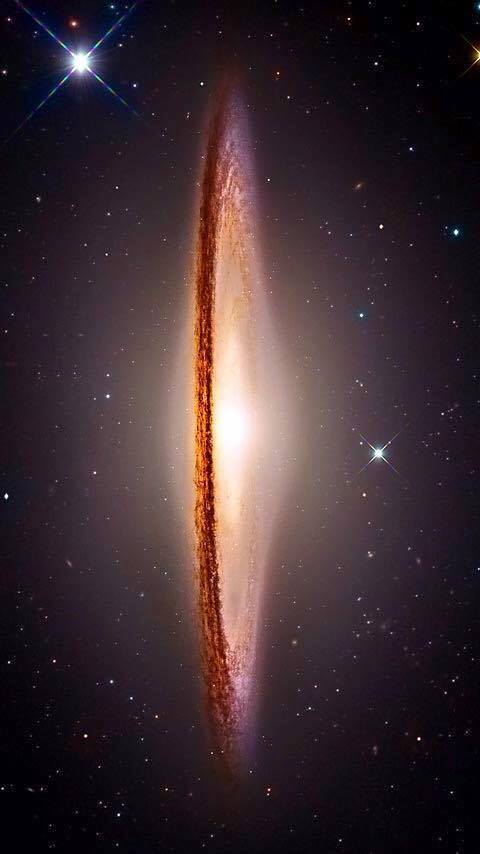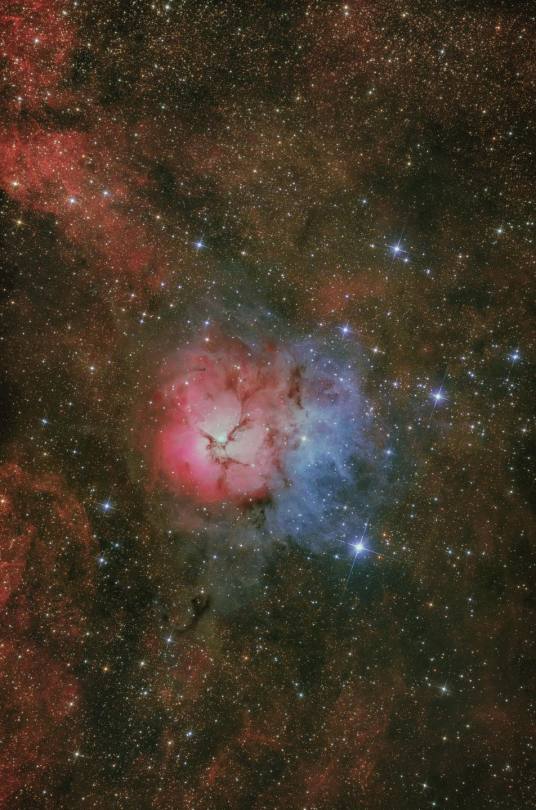Sometimes, Another Galaxy Passes Through Briefly But Changes You Forever. That’s The Tale Being Told

Sometimes, another galaxy passes through briefly but changes you forever. That’s the tale being told in this Hubble Space Telescope image of galaxy AM 0644-741. Once it was a classic spiral shape, until another galaxy passed directly through it and moved on to parts unknown. The stars, gas, and dust of the spiral arms were disrupted and pushed outward, similar to ripples after a rock has been thrown in a pond. As the ripple of galactic material plows outward into its surroundings, gas clouds collide and are compressed. The clouds can then contract under their own gravity, collapse, and form an abundance of new stars—shown here in bright blue. The core of the galaxy, glowing yellow, remains intact, though not centered. Credit: NASA, ESA, STScI. ALT TEXT: An oval-shaped galaxy with a hazy yellow core is surrounded by a ring of bright blue stars. The core is off-center, much closer to the left-hand edge of the outer ring, like the yolk of an egg. One partial arm of stars wraps beneath and to the right of the core. The remainder of space inside the galaxy’s outer ring of stars is filled with dark gas and dust, and occasional stars or star clusters seen as red or yellow dots. The outer ring of blue stars is interspersed with pink and red areas, with some glowing almost white. A scattering of stars appears in the background in blue and red, with some distant galaxies appearing hazy yellow.
More Posts from Dukeofwatts and Others

M104, Sombrero Galaxy

NGC 1566.
Credit: NASA, ESA, CSA, STScI, J. Lee (STScI), T. Williams (Oxford), R. Chandar (UToledo), D. Calzetti (UMass), PHANGS Team.

Butterfly nebula
The star or stars at its center are responsible for the nebula's appearance. In their death throes, they have cast off layers of gas periodically over the past couple thousand years. The "wings" of NGC 6302 are regions of gas heated to more than 36,000 degrees Fahrenheit that are tearing across space at more than 600,000 miles an hour.
NGC 6302 lies between 2,500 and 3,800 light-years away in the constellation Scorpius.
Credit: NASA, ESA, Joel Kastner (RIT)









'Brimham Rocks' Ancient Landscape Feature, Yorkshire.

Hubble on Its Way by NASA Hubble

IC 1295


NASA selected SpaceX to launch Europa Clipper mission with an expendable Falcon Heavy rocket.

Hubble Peers at Peculiar Galactic Pair by NASA Hubble Space Telescope








We are truly children of the stars. —Brian Cox
l all taken by David Moulton

Structure in the Tail of “Devil Comet” ©
-
 grittyedge reblogged this · 6 months ago
grittyedge reblogged this · 6 months ago -
 grittyedge liked this · 6 months ago
grittyedge liked this · 6 months ago -
 jaguarlionshark007 reblogged this · 7 months ago
jaguarlionshark007 reblogged this · 7 months ago -
 jaguarlionshark007 liked this · 7 months ago
jaguarlionshark007 liked this · 7 months ago -
 hurinmant liked this · 1 year ago
hurinmant liked this · 1 year ago -
 xploseof reblogged this · 1 year ago
xploseof reblogged this · 1 year ago -
 sunshinesrain reblogged this · 1 year ago
sunshinesrain reblogged this · 1 year ago -
 notthelunaticyourelookingfor reblogged this · 1 year ago
notthelunaticyourelookingfor reblogged this · 1 year ago -
 unpredictablestuff liked this · 1 year ago
unpredictablestuff liked this · 1 year ago -
 lesgenssucent liked this · 1 year ago
lesgenssucent liked this · 1 year ago -
 importantmentalityphilosopher liked this · 1 year ago
importantmentalityphilosopher liked this · 1 year ago -
 wachsurfer2018 liked this · 1 year ago
wachsurfer2018 liked this · 1 year ago -
 withinorbit reblogged this · 1 year ago
withinorbit reblogged this · 1 year ago -
 withinorbit liked this · 1 year ago
withinorbit liked this · 1 year ago -
 hardcoreromantism liked this · 1 year ago
hardcoreromantism liked this · 1 year ago -
 ma55x liked this · 1 year ago
ma55x liked this · 1 year ago -
 nowjunky reblogged this · 1 year ago
nowjunky reblogged this · 1 year ago -
 nowjunky liked this · 1 year ago
nowjunky liked this · 1 year ago -
 hec34 liked this · 1 year ago
hec34 liked this · 1 year ago -
 ooppen liked this · 1 year ago
ooppen liked this · 1 year ago -
 notinutah liked this · 1 year ago
notinutah liked this · 1 year ago -
 tooarbitergalaxy reblogged this · 1 year ago
tooarbitergalaxy reblogged this · 1 year ago -
 manuel82 liked this · 1 year ago
manuel82 liked this · 1 year ago -
 baaeluu liked this · 1 year ago
baaeluu liked this · 1 year ago -
 fredkeyl liked this · 1 year ago
fredkeyl liked this · 1 year ago -
 olive-mockingbird liked this · 1 year ago
olive-mockingbird liked this · 1 year ago -
 nostrand reblogged this · 1 year ago
nostrand reblogged this · 1 year ago -
 hislildino liked this · 1 year ago
hislildino liked this · 1 year ago -
 mimisalad liked this · 1 year ago
mimisalad liked this · 1 year ago -
 redlkia liked this · 1 year ago
redlkia liked this · 1 year ago -
 elfnomad liked this · 1 year ago
elfnomad liked this · 1 year ago -
 tooarbitergalaxy reblogged this · 1 year ago
tooarbitergalaxy reblogged this · 1 year ago -
 loverofnightmare liked this · 1 year ago
loverofnightmare liked this · 1 year ago -
 molpadiaau liked this · 1 year ago
molpadiaau liked this · 1 year ago -
 anastasha-romanov reblogged this · 1 year ago
anastasha-romanov reblogged this · 1 year ago -
 vincentzart liked this · 1 year ago
vincentzart liked this · 1 year ago -
 littleblackcloud1980 liked this · 1 year ago
littleblackcloud1980 liked this · 1 year ago -
 flightfright liked this · 1 year ago
flightfright liked this · 1 year ago -
 firsttoadwagonfish liked this · 1 year ago
firsttoadwagonfish liked this · 1 year ago -
 sunshinesrain liked this · 1 year ago
sunshinesrain liked this · 1 year ago -
 slinkyocelot101 liked this · 1 year ago
slinkyocelot101 liked this · 1 year ago -
 therennaissanceman liked this · 1 year ago
therennaissanceman liked this · 1 year ago -
 chaoticninjamentality liked this · 1 year ago
chaoticninjamentality liked this · 1 year ago -
 mxcellophane liked this · 1 year ago
mxcellophane liked this · 1 year ago -
 niofthedust liked this · 1 year ago
niofthedust liked this · 1 year ago -
 bigfbaby reblogged this · 1 year ago
bigfbaby reblogged this · 1 year ago